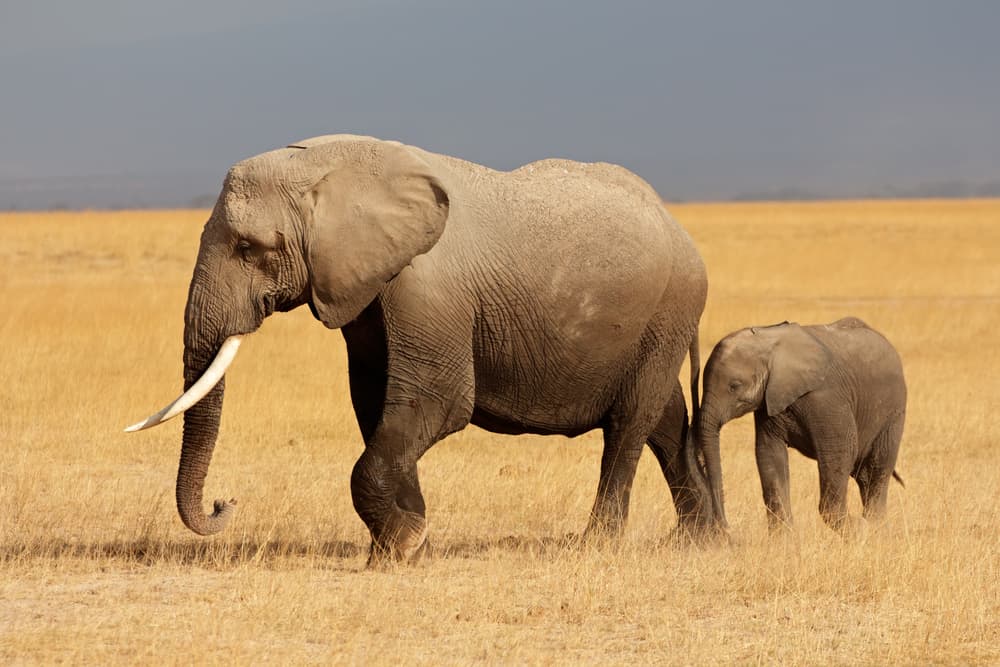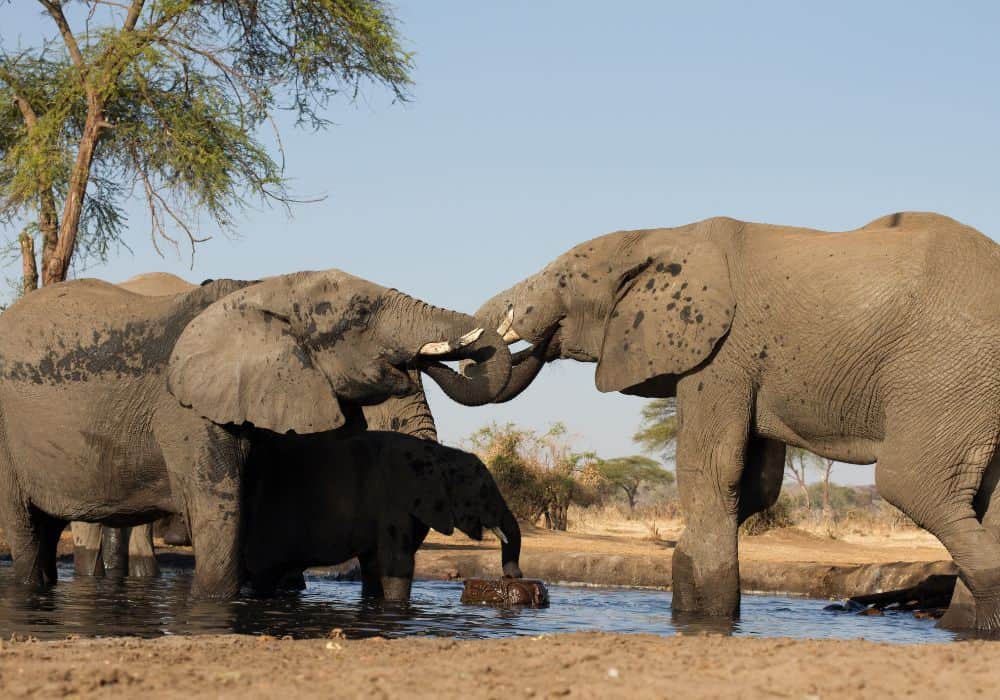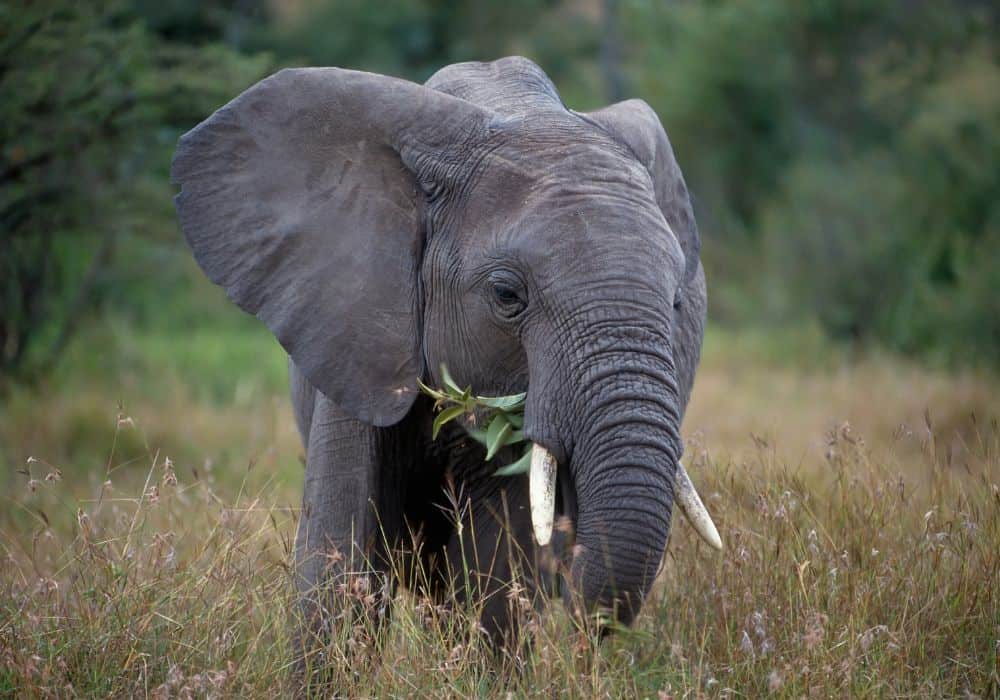Few animals are as iconic as the African elephant and none are larger, at least not on the land. Given the astounding size of this giant mammal, however, exactly what do African elephants eat? Just leaves and grass? How can such a huge mass of muscles be supported on a diet of the occasional leaf branch and a tuft of grass? To find out, let’s explore exactly what an African elephant is and what you need to know about it.
African elephant appearance description
Lots can be said about African elephants, the distinction between the different sub-species, their appearance and feeding habits, as well as their conservation status. We can’t go into too much detail in a single short article but we’ll try to cover all the most important facts below.
Everyone knows roughly what an elephant looks like but things can get a bit confusing when you’re looking at the different species of elephants. Still, before we go into the slight differences between the several elephant species, let’s go over the basics:
- As the world’s largest land animal, African elephants can be as tall as 3.3 meters at the shoulder or 10.8 feet although some are shorter than that.
- Elephants are typically more than twice longer than they are tall with many adult elephants growing up to 7.5 meters in length or 24.6 feet.
- The average weight of an African elephant can be as much as 6 tonnes (6,000 kg) or 13,200 lb. Only males tend to get as heavy, however, with females usually staying around the 3 ton (3,000 kg) or 6,600 lb range.
- The upper lip of an elephant (or its nose, essentially) is always elongated into a massive trunk the animal uses to pick up objects, pull down branches, get food, spray water on its back, or to communicate with other elephants. An adult elephant’s trunk can be as long as 210+ cm or 7 feet.
- All elephants also have giant tusks coming out of the sides of their mouths. Both males and females have them as they are basically just oversized incisor teeth. Some elephants’ tusks grow longer and point to the side while others’ are a bit shorter and point downwards. Either way, all elephants use their tusks to dig, mark their territory, to help them eat, or to fight.
- An elephant’s skin is usually a shade of grey or beige, depending on the exact species of the elephant, its age, and the overall condition of its skin. It’s also quite thick and rough too, making it an excellent protective layer against Africa’s many large predators, including lions.
- African elephants also have large fan-like ears that are significantly bigger than those of Asian elephants. This is not an accident but is a direct evolutionary adaptation as the larger ears help African elephants to radiate any excess heat out of their bodies and stay cool in even the hottest weather.
- The eyes of these animals appear small compared to their huge heads and are placed on both sides of the base of the trunk. This gives them an ideal field of vision as they can look both to the front and to the sides of the elephant’s head.
- People rarely talk about elephants’ tails as they are less consequential than the rest of their physical features. Like most animals in the savannah, elephants used their tails mostly just to swat away insect pests that are bothering them and the elephant can’t reach with its trunk. The tail is usually seen as “short” compared to the elephant’s body but it can actually be as long as 1.3 meters or over 4 feet.
Habitat and distribution of the different species of African elephants
By definition, African elephants’ habitat is the continent of Africa whereas Asian elephants live in southern Asia, including countries such as Bangladesh, Bhutan, Cambodia, China, India, Indonesia, Laos, Malaysia, Myanmar, Nepal, Sri Lanka, Thailand, and Vietnam.
Unlike their Asian counterparts, however, African elephants are further divided into two sub-species based on where exactly in Africa they live – these are the African forest elephants (Loxodonta africana cyclotis) and the African savanna elephants (Loxodonta africana africana) also known as African bush elephants.
We’ll examine the slight physical differences between the two below but the difference in their habitat is rather clear
African forest elephants
They leave in the dense African forests of Gabon, the Republic of Congo, as well as sparse populations in Côte d’Ivoire, Liberia, Central African Republic, Cameroon, Ghana, and Equatorial Guinea.
Overall, African forest elephants live in smaller herds and have slower reproductive cycles which means that they have a much harder time dealing with poaching. So, finding a forest elephant herd in the wild is getting more difficult with each passing year and we may soon be only able to see them in a zoo.
African savanna elephants
Savanna elephants live in the open plains of African savannahs in sub-Saharan Africa. They can be seen in countries such as Kenya, Namibia, Botswana, Zimbabwe, Tanzania, Zambia, and South Africa. Like forest elephants, savanna elephants also live in herds of mostly female elephants led by a matriarch, however, said herds are typically much larger.
It’s also not uncommon for savanna elephant herds to often group into larger “loose families” of up to 70 animals that know each other and move together. That, combined with their faster reproductive cycle, makes savannah elephants more resistant to population loss due to hunting or environmental issues.
Both types of elephants are seen as a “facultative partially migratory species” because they move around Africa every year. They do this search for the optimal climate conditions, watering holes, and feeding grounds as the dry season and rainy season of Africa change.
What do different African elephant species eat?
As herbivores, both species of African elephants feed on vegetation. This includes all types of leaves, twigs, tree bark, roots, as well as bushes, grass, and fruits. From these sources, elephants get all the nutrients, minerals, and calcium their giant bodies require to maintain their powerful bodies and muscles.
A smaller elephant calf can’t reach most trees, of course, but is usually helped by its mother who lowers tree branches or breaks them off entirely. That, plus grazing on bushes and grass is enough for an elephant calf to comfortably grow.
How do African elephants eat?
Watching an elephant eat is a fascinating sight as they will use both their trunks and their tusks to aid in the task. Elephants aren’t the most agile creatures so bending to graze on grass can be tricky. Instead, they will pull grass with their trunks or pull branches down to the level of their mouth. They also use their tusks to get roots out or to break tree bark off of trees.
How much do African elephants eat per day?
This herbivore diet raises the obvious question of how can such grazers reach such gargantuan sizes and impressive musculatures on just grass and leaves? How much does an elephant need to eat every day to survive? The answer, obviously, is – quite a lot.
The average adult African elephant consumes over 130 kg or about 300 lb of food a day. The larger males – especially savanna elephant males – can eat even more than that while females eat less. In both cases, however, those quantities and diet mean that elephants spend most of their time walking around and grazing on everything they can find while their digestion is working non-stop.
Interestingly enough, this diet also means that elephants sleep just about 2 hours a night so they can spend the other 22 hours of the day walking around and eating. In zoos, these animals tend to sleep more than that, usually up to 4 or 6 hours a day but that’s largely because they don’t have much else to do as well as thanks to the lack of predators around them.
Granted, even in the wild adult elephants don’t have many (or any) natural predators, however, sleeping for too long can be dangerous for their small calves as they can get ambushed by a lion pride.
Related to their impressive feeding habits is the amount of water elephants need to drink every day – about 200 liters or 50 gallons of water a day. This is another big reason for their constant migrations as finding enough water can be difficult during the savannah’s dry season.
Africa Elephants Conservation
The ivory trade and poaching for sport are the two main reasons why African elephants are endangered today along with the constant changing and restrictions of their habitats. Additionally, while a lot of African governments and NGO groups are working actively for the conservation of both forest and savanna elephants, the migratory nature of these animals as well as the vast areas they occupy, makes all conservation efforts very difficult and not entirely effective.
Still, international conservation efforts are ongoing and focus primarily on limiting ivory stockpiles and harvesting, establishing wildlife reserves, as well as staffing and strengthening areas and country borders with anti-poaching patrols as well as avoiding incidental human-animal conflicts.
Conclusion
African elephants have a strict herbivore diet of rather impressive quantities needed to support their immense weight. This diet as well as their water requirements forces these large animals into a near-constant migration pattern that makes conservation efforts difficult and allows poachers lots of opportunities for hunting elephants for their precious ivory.


